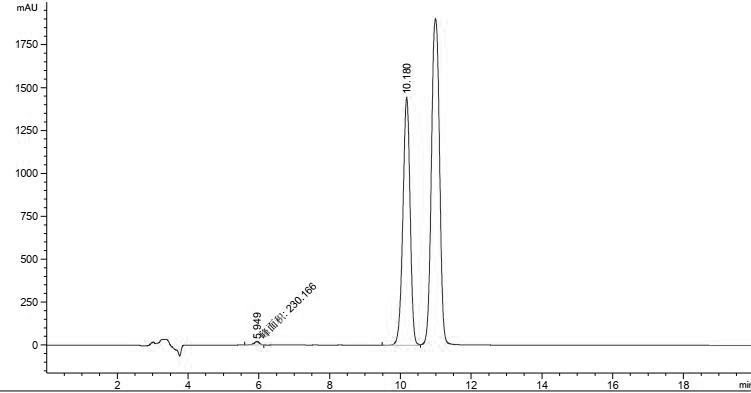Green preparation process of 2-methyl-3-methoxybenzoyl chloride
A technology of methoxybenzoyl chloride and methoxybenzoyl chloride solution is applied in the field of synthesis of organic pesticide intermediates, and can solve the problem that 2-methyl-3-methoxybenzoic acid is not easily available, environment and worker health Great harm to the health of workers in the working environment, etc., to avoid the harm to the working environment and the health of workers, good economic and social benefits, and low toxicity
- Summary
- Abstract
- Description
- Claims
- Application Information
AI Technical Summary
Problems solved by technology
Method used
Image
Examples
Embodiment 1
[0037] (1) Hydrolysis: Add methyl 2-methyl-3-methoxybenzoate (80 g, 0.44 mol) and water (50 g) into the reaction kettle, raise the temperature to 90-100°C, add liquid caustic soda (59.8 g , 0.45 mol, 1.01 eq., concentration: 30%) solution, dropwise time 0.2h, after addition, the external temperature rises to 120-130 ℃, methanol is distilled out while reacting (distillate: 16.1 g, water content: 17.3 %);
[0038] (2) Neutralization: When the reaction is completed, cool down to 50-55°C, add 147 g of ethyl acetate, and add 107 g of 20% sulfuric acid dropwise under heat preservation, and control the dropping time for 0.1-1.0 h;
[0039] After the addition is completed, keep the temperature at 55-60°C for standing and stratification; the organic layer is to be washed with water, and the water layer is collected (about 214 g), cooled to 0-5°C for crystallization, and filtered to obtain about 47 g of sodium sulfate decahydrate, and 166 g of the filtrate ;
[0040] Add 50 g of water...
Embodiment 2
[0044](1) Hydrolysis: Add methyl 2-methyl-3-methoxybenzoate (160 g, 0.89 mol) and water (100 g) into the reaction kettle, raise the temperature to 90-100°C, add liquid caustic soda (120.0 g , 0.91 mol, 1.03 eq., concentration: 30.5%) solution, dropwise time 0.25 h, after addition, keep warm at 100-110°C for reaction, and distill methanol at the same time (distillate: 45.9 g, water content: 50%);
[0045] (2) When the reaction is completed, cool down to 75-80°C, add 600 g of isopropyl acetate, and add 140 g of 30% sulfuric acid dropwise under heat preservation, and control the dropping time for 0.1-1.0 h;
[0046] After the addition, keep the temperature at 55-60°C for standing and stratify; the organic layer is to be washed with water, and the water layer is collected (about 340 g), cooled to 5-10°C for crystallization, and filtered to obtain about 98 g of sodium sulfate decahydrate and 240 g of the filtrate ;
[0047] Add 100 g of water to the organic layer, keep warm at 50-...
Embodiment 3
[0051] (1) Hydrolysis: Add methyl 2-methyl-3-methoxybenzoate (100 g, 0.55 mol) and water (72 g) into the reaction kettle, raise the temperature to 90-100°C, add potassium hydroxide (109.0 g, 0.58mol, 1.05 eq., concentration: 30.0%) solution, dropwise addition time 0.33 h, after addition, keep warm at external temperature for 110-120 to react, and distill methanol at the same time (distillate: 20 g, water content: 34% );
[0052] (2) When the reaction is completed, cool down to 75-80°C, add 460 g of methyl isobutyl ketone, and add 86.7 g of 30% sulfuric acid dropwise under heat preservation, and control the dropping time for 0.5-1.0 h;
[0053] After the addition, keep the temperature at 50-60°C for standing and stratify; the organic layer is to be washed with water, and the water layer is collected (about 256 g), cooled to 0-5°C for crystallization, and filtered to obtain about 31 g of potassium sulfate and 226 g of the filtrate;
[0054] Add 70 g of water to the organic laye...
PUM
 Login to View More
Login to View More Abstract
Description
Claims
Application Information
 Login to View More
Login to View More - R&D
- Intellectual Property
- Life Sciences
- Materials
- Tech Scout
- Unparalleled Data Quality
- Higher Quality Content
- 60% Fewer Hallucinations
Browse by: Latest US Patents, China's latest patents, Technical Efficacy Thesaurus, Application Domain, Technology Topic, Popular Technical Reports.
© 2025 PatSnap. All rights reserved.Legal|Privacy policy|Modern Slavery Act Transparency Statement|Sitemap|About US| Contact US: help@patsnap.com


